nn
n
n Prognostications were viewed with suspicion innEngland. Prior to the early sixteenth century, those published in the countryntended to be translation of foreign prognostications, possibly because of thendim view of prophecy taken by the Church. Pope Innocent VIII issued a PapalnBull Summis Desiderantes Affectibus (Desiring with Supreme Emotion) inn1484, which was instrumental in the Inquisition’s suppression of witchcraft innEurope. In 1542, Henry VIII’s Witchcraft Act defined witchcraft as a felony,npunishable by death, and removed the right of Benefit of Clergy, whereby anyonenconvicted could be spared hanging if they were able to read verses from thenBible.
n
n
n
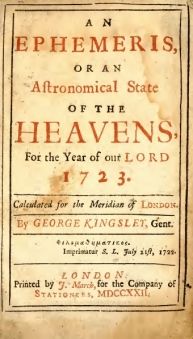 |
| George Kingsley – An Ephemeris, or an Astronomical State of the Heavens – 1723 |
n
n
n
nIn such an atmosphere, it is not unsurprising that would-benprognosticators cautiously kept their heads below the parapet; the firstnprinted English Almanack and Prognostication, by Andrew Boorde, acknowledged innthe preface that prognosticating was against the laws of both God and thenrealm. Henry’s statute was repealed by his son, Edward VI, in 1547, and anothernWitchcraft Act, of 1562, issued by Elizabeth I, was much more specific in itsndefinitions of what constituted witchcraft, sorcery and divination.
n
n
n
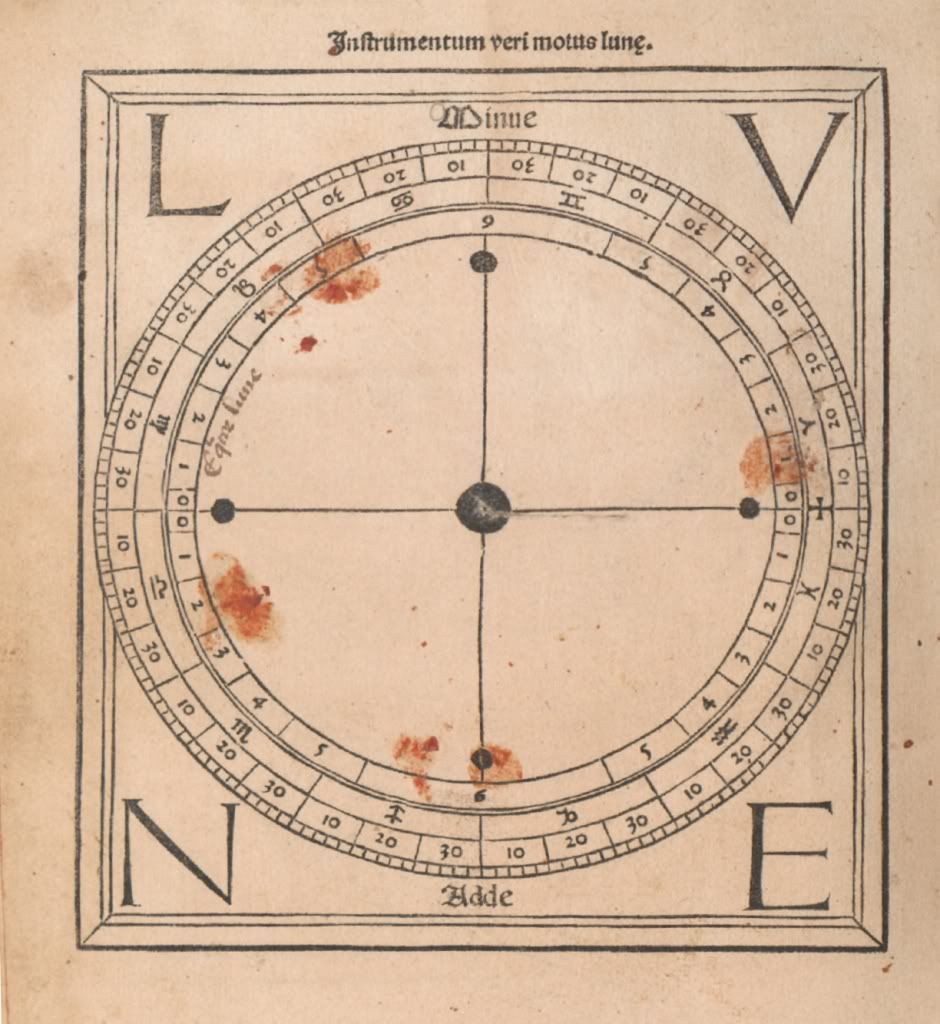 |
| Iohannes Regiomontanus – Astronomical Diagram for June 1483 |
n
n
n
nEnglishnprognosticators tended to issue quite mild prophecies, often regarding thenweather and the diseases that might follow its effects, although they did get anlittle more voluble when eclipses and comets occurred, whereas their Europeanncounterparts were much more imaginative in their forebodings of death andndisaster. From around 1540, the separate calendar and prognostication sheetsnbegan to be published together, annually, containing information on whatnweather might be expected, the changes of the moon, eclipses, an astronomicalnman with figures from the zodiac which ruled its bodily parts, the rules ofnphlebotomy and so forth.
n
n
n
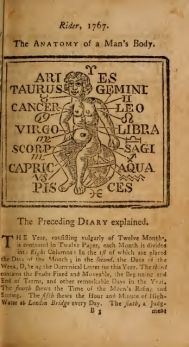 |
| Astrological Figure – Rider’s Almanack – 1767 |
n
n
n
nThe former separate sheets had been intended to benfixed on the walls of homes or merchants offices, but the later booklets werenissued to be used as cheap and readily accessible works of reference. WhennHenry VIII began his reforms of the English church, the former practice ofnmarking the years by the Saints’ Days began to be viewed with suspicion ofnpopery, but the universities and the law, together with other bodies, used anspecific Saint’s day (Michaelmas, Hilary, etc) rather than the day of thenmonth, for marking deeds, leases, documents, term-times and so forth; followingnthe Reformation, the lesser Saints’ days were removed, with only the major daysnnoted.
n
n
n
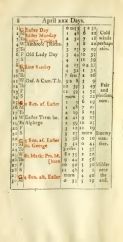 |
| The Royal Kalendar – April 1765 – (Note only the more important ‘Red Letter‘ days) |
n
n
n
nAlthough published together, it was normal practice for the almanac andnthe prognostication to be separated within the text, with separate title pagesn(presumably so that the more puritanical patrons could discard the bits thatnoffended their sensibilities), and as they developed, blank diary pages werenadded, together with information about the principal fairs, highways, the datesnof the monarchs and their birthdays, basic medical cures and recipes, and othernuseful or interesting facts. Although the almanacs were sold for 1d or 1½d,nthey were sold in such numbers that they rivalled only bibles as the mostnpopular and lucrative works sold by booksellers and patents were jealouslynguarded.
n
n
n
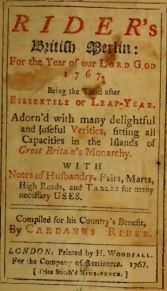 |
| Rider’s British Merlin – 1767 |
n
n
n
nThe Stationers Company required that all published books be entered atnStationers’ Company Register, where the right to sell copies were issuedn(hence, ‘copyright’), and stiff fines were liable if illegal copies werenprinted or sold (12d for every unregistered copy sold was not unusual). ThenStationer’s Company rigorously protected what they regarded as their solenpreserve, and in 1603, they formed the English Stock, funded by shares from thenmembers, which controlled the highly lucrative trade in almanacs.
n
n
n
 |
| Almanac Day at Stationers’ Hall |
n
n
n
nThe annualnpublication of the almanacs (on or about November 22nd), was markednwith immense activity at Stationers’ Hall, as porters carried out great bundlesnof new almanacs to be delivered to booksellers throughout the country. Theynwere perfectly comfortable selling the astrological prognosticators and, fromnthe end of the seventeenth century, satirical works that openly mocked thenreliance of the more gullible public on the spurious prophesying. Of the formernpublications, perhaps the most popular was Old Moore’s Almanack, writtennby a self-educated astrologer and physician, Francis Moore, which was firstnissued in 1697.
n
n
n
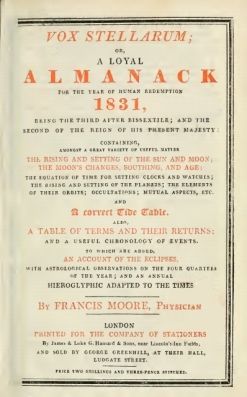 |
| Francis Moore – Vox Stellarum – 1831 |
n
n
n
nHis first almanac contained predictions about the weather, andnMoore went on to write the Vox Stellarum (Voice of the Stars), whichndeveloped into his astrological Almanack, with predictions of worldnevents for the coming year, together with more ‘conventional’ information, andncontinues to be issued today (not to be confused with Old Moore’s Almanacn– spelled without a /k/ – which is an Irish publication).
n
n
n
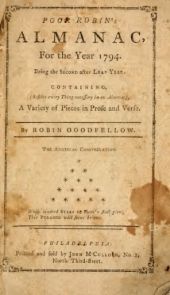 |
| Poor Robin’s Almanac – 1794 |
n
n
n
nThe morensatirical almanacs began with Poor Robin’s Almanac, in 1664, whichncontained such useful speculations that in January,
n
n
n
n“… there will be muchnfrost and cold weather in Greenland.”n
n
n
nUnder February, the prediction was,
n
n
n
n“Wenmay expect some showers of rain this month, or the next, or the next afternthat, or else we shall have a very dry spring.”n
n
n
nPoor Robin’s Almanacncontinued to be published until 1828, and was a coarse mixture of thenblindingly obvious with the down-right indecent, leavened with a health dose ofnscepticism, although later editions replaced the bawdery with blander home-spunnhomilies.
nnn
n
nnn
nTomorrow – I Prognosticate a more serious series of Almanacks
nnn
n
